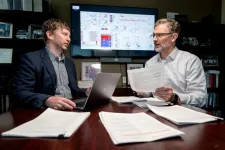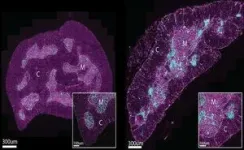(Press-News.org) Researchers at Children’s Hospital of Philadelphia (CHOP), St. Jude Children’s Research Hospital (St. Jude) and the Children’s Oncology Group (COG) today announced a significant paradigm shift in the understanding of T-lineage acute lymphoblastic leukemia (T-ALL), an aggressive and high-risk form of cancer, to one frequently driven by genetic changes in non-coding portions of our DNA. The collaborative study, supported by the Gabriella Miller Kids First Pediatric Research Program (Kids First) and National Institutes of Health (NIH) Common Fund, was published today in the journal Nature.
Many children, adolescents, and young adult patients with T-ALL traditionally respond well to initial treatment. However, patients who relapse or have treatment-resistant disease often face a dire prognosis. Given the aggressive nature and rapid progression of the disease, and limited understanding of the genetic basis of T-ALL, researchers saw an urgent need for new and effective approaches to diagnosis and treatment.
“This paper is the first to transcend previous barriers and comprehensively profile the whole genome, uncovering critical insights in more than 1,300 children, adolescents and young adults with T-ALL,” said David T. Teachey, MD, an attending physician, Director of Clinical Research at the Center for Childhood Cancer Research at CHOP and Chair of the Acute Lymphoblastic Leukemia disease committee in the COG. “These findings are a significant clinical advancement, as the goal in treating T-ALL is to prevent relapse, which requires identifying the patients most at risk. This data now makes it possible to risk stratify patients with T-cell leukemia, identifying those with a high-risk of relapsing so we can treat them with newer or alternative medicines.”
Prior studies were unable to identify important genetic changes in T-ALL, as they focused on the coding genome, the part of DNA that encodes proteins, the building blocks of cells. However, only 1% of DNA is coding, while the other 99% is termed non-coding.
Once considered useless, scientists now recognize that the non-coding region plays a key role in regulating biological processes. It signals the cell when to produce certain proteins, like a crossing guard aiding people to safely cross the street.
In this case, researchers studied more than 1,300 patients treated on the COG AALL0434 clinical trial and sequenced both the tumor and non-tumor genomes of each patient. While the researchers previously suspected that non-coding DNA in T-ALL played an important role, this study’s findings are the first ever to establish that at a large scale.
The study found that approximately 60% of the genetic changes driving T-ALL cancer cells are non-coding changes. This fundamentally alters the way researchers think about T-ALL, offering a better understanding of disease biology. This leads to innovative treatments, including new immunotherapies developed at CHOP and St. Jude.
Traditionally, patients with T-All have been categorized by risk based on their therapy response and immunophenotype, which profiles cell surface proteins as part of the diagnostic workup. While cell surface protein expression helps define T-ALL subtypes, it hasn’t proven effective in consistently identifying which patients have a good prognosis. The new comprehensive data revealed why, strongly suggesting that a genomic approach replace the current immunophenotypic classification. As a result, the researchers developed models that incorporate genetics and response to treatment to risk stratify patients with T-ALL accurately and are currently in the process of validating results using patient samples from the next COG trial of T-ALL.
“It was striking how abundant these non-coding changes were and how many of them were enhancer perturbation events, whether it was hijacking or co-option of an existing enhancer, or changes that generated a new enhancer,” said Charles Mullighan, MBBS, MD, St. Jude Children’s Research Hospital, Comprehensive Cancer Center deputy director and Department of Pathology member. “We now have a much stronger framework to take these alterations back to the lab and say now we've got better information to build the right models to understand the biology, and then to test therapy. We have very clear information that these are the sorts of alterations that people need to focus on to build a diagnostic test.”
Researchers were able to classify T-ALL into 15 subtypes with distinct gene expression and genomic drivers, including previously undefined subtypes. They refined the classification of known subtypes and showed that driver lesions, other genetic changes, and the original cell type work together to define the genomic subtype and the clinical and biological characteristics of a condition. They also observed a significant link between the type of gene alterations and outcomes in T-ALL. This new observation shows it is not only which gene is altered in the cancer cells, but also how it is altered, that helps define prognosis and chance of a cure.
“Future research must continue to determine broader applications for this approach,” said Teachey. “These findings offer a strong a roadmap for improving patient outcomes and curing more children and adults with T-ALL.”
Authors and funding
The study’s other authors are Brent Wood, Children's Hospital Los Angeles; Jason Xu, Jonathan Sussman and David Frank, University of Pennsylvania; Changya Che, Haley Newman, Elizabeth Li, Lahari Uppuluri, Rawan Shraim, Alexander Li, Kathrin Bernt, Tiffaney Vincent, Stephen Hunger, Kai Tan and Caroline Diorio, Children's Hospital of Philadelphia; Soheil Meshinchi and Rhonda Ries, Fred Hutchinson Cancer Research Center; Stuart Winter, Children’s Minnesota Research Institute; Kimberley Dunsmore, University of Virginia Children’s Hospital; William Carroll and Elizabeth Raetz, NYU Langone Health; Nilsa Ramirez, Nationwide Children’s Hospital; Mignon Loh, Seattle Children’s Hospital; Petri Pölönen, Danika Di Giacomo, Anna Seffernick, Abdelrahman Elsayed, Shunsuke Kimura, Francesca Benini, Lindsey Montefiori, Zhongshan Cheng, Jason Myers, Ilaria Iacobucci, Dale Hedges, Yawei Hui, Caroline Diorio, Yiping Fan, Yunchao Chang, Meenakshi Devidas, Hiroto Inaba, Aaron Philips, Richard Kriwacki, Jun Yang, Evadnie Rampersaud, Ti-Cheng Chang, Gang Wu and Stanley Pounds of St. Jude.
In addition to the Gabriella Miller Kids First Pediatric Research Program (X01HD100702) and National Institutes of Health (NIH) Common Fund, this work was supported by grants from the National Cancer Institute (R03CA256550, R01CA193776, U10CA180886, R01CA264837, U10CA18099, U24CA114766, U24CA196173, R01GM115634, 1U54CA243124-0, P30CA021765, R35CA197695, U54CA243124, T32CA236748, 5F32CA254140, and P30CA021765), Alex’s Lemonade Stand Foundation, the Leukemia and Lymphoma Society, Hyundai Hope of Wheels, the St. Jude Chromatin Collaborative, St. Jude Children’s Research Hospital Hematological Malignancies Program Garwood Fellowship, and ALSAC, the fundraising and awareness organization of St. Jude.
Read the full text of the Nature article: The genomic basis of childhood T-lineage acute lymphoblastic leukemia
St. Jude Children's Research Hospital
St. Jude Children's Research Hospital is leading the way the world understands, treats and cures childhood cancer, sickle cell disease, and other life-threatening disorders. It is the only National Cancer Institute-designated Comprehensive Cancer Center devoted solely to children. Treatments developed at St. Jude have helped push the overall childhood cancer survival rate from 20% to 80% since the hospital opened more than 60 years ago. St. Jude shares the breakthroughs it makes to help doctors and researchers at local hospitals and cancer centers around the world improve the quality of treatment and care for even more children. To learn more, visit stjude.org, read St. Jude Progress, a digital magazine, and follow St. Jude on social media at @stjuderesearch.
Children’s Hospital of Philadelphia
A non-profit, charitable organization, Children’s Hospital of Philadelphia was founded in 1855 as the nation’s first pediatric hospital. Through its long-standing commitment to providing exceptional patient care, training new generations of pediatric healthcare professionals, and pioneering major research initiatives, the hospital has fostered many discoveries that have benefited children worldwide. Its pediatric research program is among the largest in the country. The institution has a well-established history of providing advanced pediatric care close to home through its CHOP Care Network, which includes more than 50 primary care practices, specialty care and surgical centers, urgent care centers, and community hospital alliances throughout Pennsylvania and New Jersey, as well as the Middleman Family Pavilion and its dedicated pediatric emergency department in King of Prussia. In addition, its unique family-centered care and public service programs have brought Children’s Hospital of Philadelphia recognition as a leading advocate for children and adolescents. For more information, visit https://www.chop.edu.
END
New research from Children’s Hospital of Philadelphia and St. Jude poised to transform approach to diagnosing and treating acute leukemia in children
Findings show genetic changes in non-coding DNA impact outcomes.
2024-08-14
ELSE PRESS RELEASES FROM THIS DATE:
New clue into the curious case of our ageing immune system
2024-08-14
A WEHI study could help solve a long-standing mystery into why a key immune organ in our bodies shrinks and loses its function as we get older.
The thymus is an organ essential for good health due to its ability to produce special immune cells that are responsible for fighting infections and cancer.
In a world-first, researchers have uncovered new cells that drive this ageing process in the thymus – significant findings that could unlock a way to restore function in the thymus and prevent our immunity from waning as we age.
Watch and embed the video: https://youtu.be/2x1UGqNh77w
At a glance
The thymus is an organ essential for our immune defence ...
Venting your frustrations can make friends like you better – if you do it right
2024-08-14
Key takeaways
Venting about your frustrations with one friend to another may feel good, but it doesn’t necessarily reduce anger.
Experiments showed that people who listened to a friend vent liked and supported that person more than those who were vented about — but only if the person venting didn’t derogate or seem aggressive toward the other friend.
Venting might be an effective tool of competition for listeners’ affections precisely because it is not readily recognized as a tool of competition.
Venting about your frustrations with one friend to another isn’t necessarily cathartic, but it can make the friend you’re talking to like and ...
Phase 1 BAFF CAR T clinical trial for patients with relapsed and refractory multiple myeloma underway at UH Seidman Cancer Center
2024-08-14
CLEVELAND – University Hospitals (UH) Seidman Cancer Center hematologist-oncologist Leland Metheny, MD, is leading the trial. He says in the two years since the foundational pre-clinical work was completed, the team has shown that it’s feasible to manufacture BAFF CAR T-cells for human subjects. The innovation is introducing genes into T-cells via the process of electroporation in the Wesley Center for Immunotherapy at UH Seidman Cancer Center.
In January 2022, a research team from UH Seidman Cancer Center and Case Western Reserve University published a groundbreaking ...
Microscopic packets could deliver diabetes-preventing therapeutics
2024-08-14
Within each of us lies an army of cells whose topmost duty is protecting against external pathogens and internal threats such as proliferating cancer cells. Yet, immune cells can sometimes erroneously attack the body, causing autoimmune diseases like type 1 diabetes.
Texas A&M researchers recently received an RO1 grant from the National Institutes of Health to develop a strategy to deliver immune-suppressing proteins generally produced by specialized stem cells. Such an approach could potentially help reduce the immune system's attack on the insulin-producing beta-cells in the pancreas and open doors to a novel treatment for type 1 diabetes.
"We are excited that the ...
New brain-computer interface allows man with ALS to ‘speak’ again
2024-08-14
A new brain-computer interface (BCI) developed at UC Davis Health translates brain signals into speech with up to 97% accuracy — the most accurate system of its kind.
The researchers implanted sensors in the brain of a man with severely impaired speech due to amyotrophic lateral sclerosis (ALS). The man was able to communicate his intended speech within minutes of activating the system.
A study about this work was published today in the New England Journal of Medicine.
ALS, also known as Lou Gehrig's disease, affects the nerve cells that control movement ...
International study detects consciousness in unresponsive patients
2024-08-14
New research co-led by experts at Mass General Brigham found that brain scans can detect consciousness in some patients with brain injury who are unresponsive.
In the study, 241 participants with severe brain injury who do not respond when given a simple instruction were assessed with functional MRI (fMRI), electroencephalography (EEG), or both tests. During these tests, participants heard instructions, such as “imagine opening and closing your hand” followed, 15-30 seconds later by “stop imagining opening and closing your hand.” The fMRI and EEG brain ...
Manard chosen for Society of Applied Spectroscopy’s Lester W. Strock Award
2024-08-14
Benjamin Manard, an analytical chemist in the Chemical Sciences Division of the Department of Energy’s Oak Ridge National Laboratory, will receive the 2024 Lester W. Strock Award from the Society of Applied Spectroscopy.
The prize is named for the late Lester W. Strock, a crystal chemist and pioneer in applied spectroscopy. The annual award recognizes researchers who produce outstanding publications in analytical atomic spectrochemistry.
“Manard’s publications over the last five years demonstrate a clear focus on the elemental and isotopic analysis of nuclear materials using a variety ...
Patients with unexplainable chronic itch have unique blood biomarkers that could eventually lead to new targeted treatments
2024-08-14
Millions of patients worldwide suffer from a chronic itching condition with no identifiable cause – a condition known as chronic pruritus of unknown origin (CPUO) – that has no targeted therapies approved to treat it. Many of these patients suffer for years with little relief, but a new University of Maryland School of Medicine study may provide hope for future treatments. Patients were found to have lower than normal levels of metabolite biomarkers in the blood plasma that could point to a cause of their excruciating symptoms.
Findings were recently published in the journal Scientific Reports.
“Our study found a distinct deficit in certain metabolite ...
Unveiling the brain's reward circuitry
2024-08-14
PHILADELPHIA (August 14, 2024) – A research team – co-led by Penn Nursing – has made a significant breakthrough in understanding the complex neural circuitry underlying reward and addiction by identifying 34 distinct subtypes of medium spiny neurons (MSNs) in the nucleus accumbens (NAc), a key brain region involved in pleasure and motivation. The findings, published in the journal Scientific Reports by Nature, offer insights into the diversity of these neurons and their potential roles in substance ...
Do people with high blood pressure have a higher risk of Alzheimer’s disease?
2024-08-14
EMBARGOED FOR RELEASE UNTIL 4 P.M. ET, WEDNESDAY, AUGUST 14, 2024
MINNEAPOLIS – People 60 and older with untreated high blood pressure may have an increased risk of Alzheimer’s disease compared to both people who have been or are being treated for high blood pressure as well as people without the chronic condition. The new research, a meta-analysis, is published in the August 14, 2024, online issue of Neurology®, the medical journal of the American Academy of Neurology. These results do not prove that untreated high blood pressure causes Alzheimer’s disease, they only show ...
LAST 30 PRESS RELEASES:
Orthopedics can play critical role in identifying intimate partner violence
Worms as particle sweepers
Second spider-parasitic mite described in Brazil
January 2026 issues of APA journals feature new research on autism, pediatric anxiety, psychedelic therapy, suicide prevention and more
Private equity acquired more than 500 autism centers over the past decade, new study shows
New cervical cancer screening guidelines from the US Department of Health and Human Services
Estimated burden of COVID-19 illnesses, medical visits, hospitalizations, and deaths in the US from October 2022 to September 2024
Smartphone use during school hours by US youth
Food insecurity and adverse social conditions tied to increased risk of long COVID in children
Earliest, hottest galaxy cluster gas on record could change our cosmological models
Greenland’s Prudhoe Dome ice cap was completely gone only 7,000 years ago, first GreenDrill study finds
Scientific validity of blue zones longevity research confirmed
Injectable breast ‘implant’ offers alternative to traditional surgeries
Neuroscientists devise formulas to measure multilingualism
New prostate cancer trial seeks to reduce toxicity without sacrificing efficacy
Geometry shapes life
A CRISPR screen reveals many previously unrecognized genes required for brain development and a new neurodevelopmental disorder
Hot flush treatment has anti-breast cancer activity, study finds
Securing AI systems against growing cybersecurity threats
Longest observation of an active solar region
Why nail-biting, procrastination and other self-sabotaging behaviors are rooted in survival instincts
Regional variations in mechanical properties of porcine leptomeninges
Artificial empathy in therapy and healthcare: advancements in interpersonal interaction technologies
Why some brains switch gears more efficiently than others
UVA’s Jundong Li wins ICDM’S 2025 Tao Li Award for data mining, machine learning
UVA’s low-power, high-performance computer power player Mircea Stan earns National Academy of Inventors fellowship
Not playing by the rules: USU researcher explores filamentous algae dynamics in rivers
Do our body clocks influence our risk of dementia?
Anthropologists offer new evidence of bipedalism in long-debated fossil discovery
Safer receipt paper from wood
[Press-News.org] New research from Children’s Hospital of Philadelphia and St. Jude poised to transform approach to diagnosing and treating acute leukemia in childrenFindings show genetic changes in non-coding DNA impact outcomes.






